Podcast: Play in new window | Download
Subscribe: Apple Podcasts | RSS
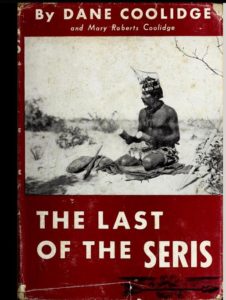 In the late 1930s, two American anthropologists, Dane and Mary Coolidge, lived among the Seri Indians of the desert coastal regions of the Mexican state of Sonora. At the time, many considered the Seris to be the most untouched native group in Mexico. Due to their relative isolation and because much of their ancient culture remained intact, the Seri people generated a great deal of attention from researchers in the early 20th Century. Knowing that the fragile culture of the Seri people was in danger of being lost, the Coolidges went to the desert shores of the Sea of Cortez to live among the Seri for six weeks. They were interested in talking to the elders of the tribe to document ancient myths and legends, specifically. A certain legend that Dane Coolidge had heard about while living in the States intrigued him a great deal. In the Seri mythology there exists a story of a group of white giants who landed on the shores of Tiburón Island sometime in antiquity. While living among the Seri the Coolidges made sure to ask the tribal elders to recount the tales of the mysterious foreign strangers. It eventually became a chapter of their book published in 1939 called The Last of the Seris.
In the late 1930s, two American anthropologists, Dane and Mary Coolidge, lived among the Seri Indians of the desert coastal regions of the Mexican state of Sonora. At the time, many considered the Seris to be the most untouched native group in Mexico. Due to their relative isolation and because much of their ancient culture remained intact, the Seri people generated a great deal of attention from researchers in the early 20th Century. Knowing that the fragile culture of the Seri people was in danger of being lost, the Coolidges went to the desert shores of the Sea of Cortez to live among the Seri for six weeks. They were interested in talking to the elders of the tribe to document ancient myths and legends, specifically. A certain legend that Dane Coolidge had heard about while living in the States intrigued him a great deal. In the Seri mythology there exists a story of a group of white giants who landed on the shores of Tiburón Island sometime in antiquity. While living among the Seri the Coolidges made sure to ask the tribal elders to recount the tales of the mysterious foreign strangers. It eventually became a chapter of their book published in 1939 called The Last of the Seris.
The Seris call themselves the Comcaac and the name “Seri” is believed to be a name given to this group by the neighboring Yaqui people. “Seri” may mean “people of the desert,” but this is not certain. Some researchers also believe that the name comes from the language of Opata people to the northeast of Seri territory. The Seri are not related to other neighboring indigenous groups. Their language puzzles linguists and is considered a language isolate in that it has no related languages that exist anywhere. Seri is only one of the four language isolates in Mexico and today only has about 700 fluent speakers. The first contacts that the Seri had with Europeans date to the late 17th Century. Outsiders had very little interest in Seri territory which they considered to be too harsh and not viable to develop or exploit. Missionaries arrived in the 1690s and were met with hostility. Unfounded tales of Seri cannibalism kept away curious foreigners for centuries, although stories of gold on Tiburón Island brought a few curious fortune hunters from the United States and other parts of Mexico. In most cases, those bitten by the gold bug did not make it out of Seri territory alive, succumbing to the elements or meeting their demise at the hands of the less-than-welcoming Seris. According to the Seri creation story there were once 12 bands of Seris originating from 12 sisters. These 12 bands once roamed the entire length of the northwestern shores of the Sea of Cortez in the modern Mexican state of Sonora with part of one band living across the sea in the eastern coast of Baja. In more recent times anthropologists have identified 6 distinct groups which eventually blended into the one single group we see today. The Seris now live in two municipalities on the mainland, Punta Chueca and El Desemboque, and seasonal encampments on the islands of Tiburón, also called Tahejoc, and San Esteban, also called Cofteecol. The Mexican government granted Tiburón Island to the Seri to be held in trust by the tribe and it is now part of an ecological zone administered by the Seris. It contains many sacred sites including a series of caves. In the 1930s when the Coolidges lived among the Seri, they stayed in a small village on Isla Tiburón.
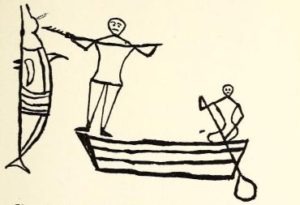 Dane and Mary Coolidge gathered most of the Seri tribal lore presented in their book from an elder named Santo Blanco. Santo Blanco recalled most of the histories and folk tales of his people through songs that had been passed down to him from elders he knew as a child. When asked to describe the legends and histories beyond the songs, Santo Blanco had a difficult time, but obliged his curious American guests. Of all the stories, the tale of the White Giants fascinated the Coolidges the most and they pressed for more information. In the words of Santo Blanco:
Dane and Mary Coolidge gathered most of the Seri tribal lore presented in their book from an elder named Santo Blanco. Santo Blanco recalled most of the histories and folk tales of his people through songs that had been passed down to him from elders he knew as a child. When asked to describe the legends and histories beyond the songs, Santo Blanco had a difficult time, but obliged his curious American guests. Of all the stories, the tale of the White Giants fascinated the Coolidges the most and they pressed for more information. In the words of Santo Blanco:
“There was a race of white giants who came here long ago. We called them Ahnt’-tay ah hek’tahm, the ‘Came from Afar Men.’ They had white hair and were so big it took two bushels of tobacco to fill their pipes. They came on a big ship, in which they lived all the time, and went out in boats to kill whales. When they speared one, a man would pick it up and put in on the ship.
They cooked the whale meat in an enormous iron pot, ate it and drank the oil. They did not drink mezcal but smoked lots of tobacco. This was in the time of the Old Seris, before the Spanish came. They wore hats so big it took twelve men to lift them and had a liquor of their own. They would not sell this liquor; they drank it themselves. It is said they were very happy when they were drinking, and they sang this when they were drunk.”
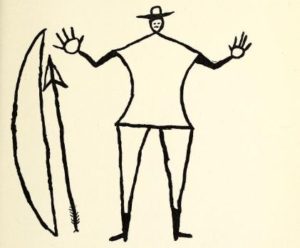 Mary Coolidge asked many specific questions of Santo Blanco. Could the Seri shaman give more precise details about what the giants looked like? According to Santo Blanco, they were more than twice the size of a grown Seri man, very muscular and strong, and had light-colored hair. Also, they had gold rings in their ears and noses and some of them had gold teeth.
Mary Coolidge asked many specific questions of Santo Blanco. Could the Seri shaman give more precise details about what the giants looked like? According to Santo Blanco, they were more than twice the size of a grown Seri man, very muscular and strong, and had light-colored hair. Also, they had gold rings in their ears and noses and some of them had gold teeth.
When Mrs. Coolidge asked about the size of the White Giants’ boat, Santo Blanco gave an interesting reply. He said:
“It was so big that four whales would not fill it. The men sat in front and behind but not in the middle of the boat.”
She then asked, “How long ago was it that they came?” Santo Blanco explained that the first people on the earth were called Wise Woman and Wise Man. He continued:
“Afterward came these giants. They came only once, and the Seris were afraid of them. All except the Old Wise Woman, who talked with them. They took four families of Seris away with them, who were all afraid to go. The Giants promised to bring them back when they returned, but they never came back.
“The Giants stayed at Tiburón a year and four months, cooking their whale meat. Their paddles were so big that each stroke would push them half a league. They did not row backwards, they paddled forward. The had no sails on their small boats. Two men paddled, one on each side.”
In the interview Santo Blanco continued to describe this strange landing party:
“There were many men and one woman in the ship, and they told the Ancient Seris that there were many more like them in their country. They lived in big houses by the sea. These Giants took the old man who composed the song of Giants to their ship and told him about their home. They said that in their country they hunted deer so big that only a Giant could kill one. The Captain told the Old Wise Woman its name was Ahp kah’ roh.
“They had bows and arrows – the arrows as big around as the circle of my fingers. They had no shields. The hide of these Giants was so thick that no Seri arrow could penetrate it.
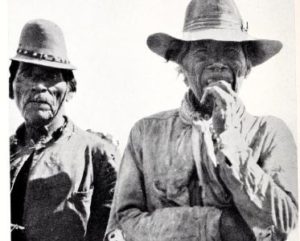 “The Giant Woman was the wife of the captain. She was whiter than the men and had red hair. She had big braids down her back. She was dressed in thick clothes and a big cloak or mantle went over her back. Her carrying basket was so big, they could cut a whale in two and she would put one half in her basket.
“The Giant Woman was the wife of the captain. She was whiter than the men and had red hair. She had big braids down her back. She was dressed in thick clothes and a big cloak or mantle went over her back. Her carrying basket was so big, they could cut a whale in two and she would put one half in her basket.
“The story says their shoes were very big and wide, but when they went hunting, they took off these shoes and wore sandals. They hunted on the mainland – they would have turned the island over if they had hunted there. They always slept in their boat and had no camp on shore. They went hunting very early in the morning. All the weapons they had were bows and arrows and spears. But that was long ago and the Seris do not know anymore.”
After returning to the States from living with the Seri Dan Coolidge remarked that a man could spend an entire lifetime of research just investigating the story of the mysterious white giants. Coolidge mentioned in his notes that thirty years before his six weeks with the Seri he had heard a story of a blue-eyed, yellow-haired people who sailed up the Mayo River just south of the Seri homeland, and how these people intermarried with the local Mayo tribe. Coolidge went to the Mayo River area to investigate and did not have any success in gathering details of this story. While in Mayo country though, he did meet an American who married into the Mayo tribe and Coolidge discussed the ancient legend of the blond seafarers with the American. Coolidge recounts part of his interview with the American:
“I learned the details of the ancient Mayo wedding ceremony; and three features of it were identical with the old Norwegian rites. The girl’s father and mother had kissed his hand and her hand, and he had to drink with all comers. A great feast had been given, and at its close the Head Chief had filled a glass full of cognac and told him to drink it all – until he did that he was not married. As a final rite, pretty girls had strewn flowers before them, and he and his bride had to walk over them crushing them underfoot.”
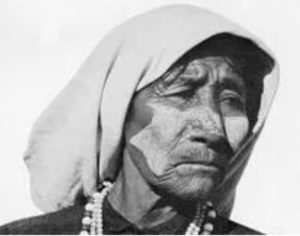 To Coolidge, there was no doubt that the White Giants of the Seri were the same strange visitors that sailed up the Mayo River immediately due south of Seri territory. He noted that the giants had no firearms, so they were a seafaring people who probably arrived before the time of Christopher Columbus. The “heavy hats” and “thick impenetrable clothing” sounded very Viking to Coolidge. Some researchers theorize that ancient Norseman arrived at the opposite end of Mexico in the Yucatán a thousand years ago during the post-Classic period of Maya civilization and clues of this may be found in the ancient Mexican myth of Votan. For more about Votan please see Mexico Unexplained Episode 32. https://mexicounexplained.com//vikings-ancient-mexico-story-votan/ Although a Viking visit to Mexico’s Caribbean coast might be plausible, it seems like a stretch to think that the Vikings had managed to get to Mexico’s west coast. If these were indeed Vikings they would have had to have sailed through an ice-free Canadian Arctic, through the Bering Strait and down along the coast of North America from Alaska to get to Mexico. Is there another explanation? Could these have been English or Dutch pirates from the 17th Century? This would explain the gold earrings and nose rings found in modern-day stereotypes of pirates, but this would not explain the lack of firearms or the presence of a woman among the men. Some researchers have dismissed the Seri stories of White Giants as fanciful myths citing the many implausible details in the legends. Others dismiss these details, saying that the transmission of these stories across the centuries is like a multigenerational game of telephone with fine points exaggerated or otherwise altered over time. With the indigenous cultures of northwestern Mexico rapidly disappearing, the true story of the White Giants of Tiburón Island may never be known.
To Coolidge, there was no doubt that the White Giants of the Seri were the same strange visitors that sailed up the Mayo River immediately due south of Seri territory. He noted that the giants had no firearms, so they were a seafaring people who probably arrived before the time of Christopher Columbus. The “heavy hats” and “thick impenetrable clothing” sounded very Viking to Coolidge. Some researchers theorize that ancient Norseman arrived at the opposite end of Mexico in the Yucatán a thousand years ago during the post-Classic period of Maya civilization and clues of this may be found in the ancient Mexican myth of Votan. For more about Votan please see Mexico Unexplained Episode 32. https://mexicounexplained.com//vikings-ancient-mexico-story-votan/ Although a Viking visit to Mexico’s Caribbean coast might be plausible, it seems like a stretch to think that the Vikings had managed to get to Mexico’s west coast. If these were indeed Vikings they would have had to have sailed through an ice-free Canadian Arctic, through the Bering Strait and down along the coast of North America from Alaska to get to Mexico. Is there another explanation? Could these have been English or Dutch pirates from the 17th Century? This would explain the gold earrings and nose rings found in modern-day stereotypes of pirates, but this would not explain the lack of firearms or the presence of a woman among the men. Some researchers have dismissed the Seri stories of White Giants as fanciful myths citing the many implausible details in the legends. Others dismiss these details, saying that the transmission of these stories across the centuries is like a multigenerational game of telephone with fine points exaggerated or otherwise altered over time. With the indigenous cultures of northwestern Mexico rapidly disappearing, the true story of the White Giants of Tiburón Island may never be known.
REFERENCES
Coolidge, Dane and Mary Roberts. The Last of the Seris. New York: E. P. Dutton & Co., 1939. Purchase the book on Amazon here: https://amzn.to/2QdpN7q

2 thoughts on “The White Giants of Tiburón Island”
I have studied this scenario for years and there could be an explanation…
http://www.lostshipofthedesert.com/giants-of-tiburon-island/
Thanks John. It looks like we used the same sources. Thanks for the link.